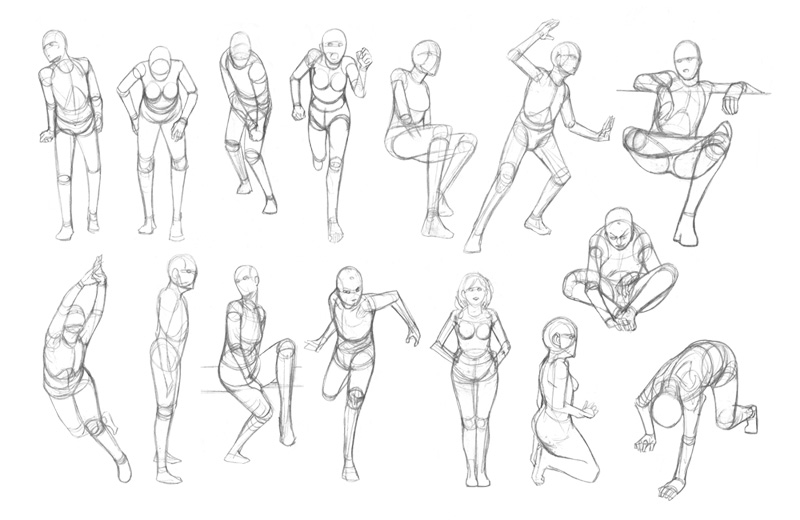When starting to learn how to draw the human figure, using a body drawing base is a must-have technique for beginners. It simplifies the complex structure of the human body into simple shapes, making it much easier to create proportional, dynamic poses. Whether you’re a hobbyist, beginner, or aspiring professional artist, mastering body drawing bases can make the process of drawing less intimidating and more fun. Let’s dive into the basics and learn how to start with a body drawing base.
What is a Body Drawing Base?
A body drawing base is a simplified framework that represents the human body. Think of it as the blueprint or skeleton of a figure. It’s not a detailed drawing but rather a rough draft made up of simple shapes like circles, lines, and rectangles to mark the body’s major parts. Artists use this base as a guide to sketch the proportions, poses, and structure before refining their drawings.
By starting with a base, you can focus on getting the overall proportions and balance right without worrying about intricate details like facial features or clothing right away. For beginners, this method reduces stress and makes the creative process more manageable.
Why Do Artists Use Body Drawing Bases?
Artists use body drawing bases because they provide a solid foundation for drawing the human form. The human body is complex, with intricate anatomy, muscles, and joints. Without a framework, it’s easy to lose proportion, making your figures look distorted or unnatural.
Using a base helps artists:
- Understand Human Proportions: By simplifying the body into shapes and lines, you’ll learn how the head, torso, arms, and legs are proportionally connected.
- Create Dynamic Poses: Body drawing bases allow artists to experiment with poses and movements, ensuring their figures look natural and balanced.
- Save Time: Starting with a base helps avoid mistakes, so you can build your drawing step by step without needing to erase and redraw constantly.
No matter your skill level, a good body drawing base will improve your art by providing structure and consistency.
How to Start Using a Body Drawing Base
Learning how to use a body drawing base is easier than you think. You just need to follow a few simple steps to get started. Below, we break it down into actionable tips.

Choose a Simple Shape to Start
Begin by breaking the body into basic shapes. For example, the head can be represented as a circle, the torso as a rectangle or oval, and the arms and legs as long cylinders. Using these simple forms will make it easier to block out the body’s general shape before adding details.
Sketch Lightly for Easy Fixes
When creating your body drawing base, use a light hand with your pencil. Don’t press too hard, as this makes erasing and adjusting the shapes more difficult. Drawing lightly allows you to experiment and make changes as you refine the pose and proportions.
Add Details After the Base
Once you’ve drawn the base, you can start adding details like facial features, clothing, and muscle definition. Remember, the base is just the starting point—it’s not meant to look like the final drawing. You can refine your work as you go along, building on the solid foundation you’ve created.
Different Types of Body Drawing Bases
There isn’t just one way to create a body drawing base. Depending on your skill level and the type of drawing you want to create; you can use different types of bases. Below, we’ll explore some of the most common methods.
- Stick Figures: The simplest form of a body drawing base, ideal for beginners.
- Geometric Shapes: A step up from stick figures, this approach uses shapes like circles, squares, and triangles to define the body’s structure.
- Advanced Bases: For experienced artists, these bases include more details, such as joints and muscle groups, to capture realistic anatomy.
Let’s dive deeper into each type to help you decide which one is right for you.
Stick Figures for Beginners
Stick figures are the most basic form of a body drawing base and are perfect for beginners. A stick figure consists of straight lines for the arms, legs, and torso, with a small circle representing the head. While simple, stick figures are highly effective for planning poses and getting a general sense of balance.
When using stick figures:
- Start by drawing a vertical line for the spine.
- Add horizontal lines for the shoulders and hips.
- Connect the limbs using straight lines.
- Ensure that the arms and legs are proportional to the torso.
Stick figures provide a quick and easy way to lay out your drawing, making them great for practice or brainstorming ideas.
Geometric Shapes for Better Proportions
Once you’re comfortable with stick figures, you can move on to using geometric shapes for your body drawing bases. This method adds a layer of complexity, helping you capture the proportions and volume of the human body.

For example:
- The head can be drawn as an oval or sphere.
- The torso can be represented with a rectangular or triangular shape.
- The arms and legs can be sketched as cylinders.
Using geometric shapes allows you to give your figures more depth and realism, helping you transition from flat stick figures to full-bodied drawings.
Advanced Bases for Complex Poses
If you’re ready for a challenge, you can use advanced body drawing bases. These include more detailed shapes and guidelines to represent anatomy, muscle structure, and joint placement. Advanced bases are ideal for drawing complex poses or capturing dynamic movement.
For instance, you might include:
- Rounded shapes for shoulders and hips to indicate joints.
- Curved lines to show the flow of movement.
- Guidelines for symmetry and balance.
Common Mistakes to Avoid with Body Drawing Bases
Even with a solid foundation, mistakes can happen. Here are some common errors to watch out for when using body drawing bases:
- Incorrect Proportions: Ensure that the head, torso, and limbs are proportionally accurate. For example, the legs should be longer than the torso.
- Skipping the Base: Many beginners jump straight into details without starting with a base, which often leads to uneven or unbalanced drawings.
- Overcomplicating the Base: Keep your base simple. Adding too much detail at the start can make it harder to adjust later.
Practice Every Day
The best way to improve your skills with body drawing bases is through consistent practice. Dedicate time each day to sketching figures using bases experimenting with different poses and proportions. Over time, you’ll notice a significant improvement in your drawings.
Tips for Improving Your Body Drawing Skills
If you’re serious about becoming better at figure drawing, here are some tips to help you improve:
- Study Anatomy: Understanding the structure of the human body will make your drawings more realistic.
- Use References: Look at photos, videos, or live models to observe how the body moves and bends.
- Experiment with Poses: Don’t stick to static poses—challenge yourself with dynamic and action-oriented positions.
- Get Feedback: Share your work with others and ask for constructive criticism to identify areas for improvement.
By incorporating these tips into your practice, you’ll develop more confidence in your drawing abilities.
The Bottom Line
Mastering the body drawing base is a fundamental step for any artist looking to improve their figure drawing skills. Whether you’re starting with stick figures or experimenting with geometric shapes, the key is to practice regularly and build a strong foundation. Remember, every great drawing begins with a solid base, so don’t skip this crucial step.
By simplifying the human form into basic shapes and lines, you’ll not only make drawing easier but also open up endless possibilities for creativity and expression. So grab your sketchbook, start with a simple body drawing base, and watch your skills grow!














Leave a Reply